
MCBJ and Metallic point contacts
What is it ?
By metallic point contacts we mean atomic sized metallic junctions sandwiched between macroscopic electrodes.During the last decades, electronic properties of atomic sized metallic contacts have interested several groups employing break junction techniques. First studies were carried out using Scanning Tunneling Microscopy in Break junction regime (STM-BJ). The second most used technique is the Mechanically Controllable Break Junction (MCBJ) developed by Muller et al in 1992 and based on an earlier design by Moreland and Ekin. Both STM-BJ and MCBJ techniques are based on the stretching of an Au wire. During stretching, the Au wire gets thinner, and finally breaks leading to two electrodes. Before breaking, at a given bias voltage, the current flowing through the junction is measured as a function of the relative elongation of Au wire. As it is expected in diffusive regime, the current first decreases linearly while the elongation of the wire. However, in the ultimate stage before breaking, while the diameter of the Au wire consists only in a few atoms, the electronic transport becomes ballistic with the conductance given by:

Where N is the number of available channels for the electrons in the junction, e the electron charge, h the Planck’s constant and Tn the transmission probability of the channels.

Electron transmission through a metallic point contact
Metallic point contacts might be viewed as waveguides, electron waves are transmitted through the constriction with a probability T
In junctions of atomic dimensions, conduction channels are directly related to wave functions of the metal \cite{scheer1998}. In the particular case of gold, the conductance of a single atom-junction is due to one conductance channel with transmission probability close to unity. Thus, its conductance is close to the conductance quantum G0 Therefore, in MCBJ or STM-BJ experiments, a gold mono-atomic junction is characterized by a constant conductance of 1G0 during the stetching of the junction, i.e. a ballistic plateau at 1G_0. It is noteworthy that the length of this plateau gives a direct access to the lifetime of the mono-atomic junction. Similarly, the ballistic plateau observed at 2G_0 is distinctive of a junction containing two atoms in its section.
MCBJ
In our home-made MCBJ (sketched in figure \ref{fig:setup}), a thin Au wire (diameter 250 microns) is glued onto a phosphorous bronze bending beam with two droplets of epoxy. The basic principle consists in stretching the wire by bending the substrate with a mechanical actuator, until the junction breaks and gives two separate electrodes. Relaxing the force on the elastic substrate by back-bending allows the junction to be closed again. The mechanical actuator is composed of a stepping motor and a piezoelectric transducer (PZT) in series, which permits to control the process by ramping the z-piezovoltage. Because the wire is fixed, the vertical movement of the PZT is demagnified, allowing accurate control of wire stretching (elongation). The relative elongation can reach a resolution in the range of 5 picometers. Moreover, the MCBJ exhibits an outstanding mechanical stability (<5pm/s drift of the electrodes after breaking at room temperature for our setup). This stability results from the reduction of the mechanical loop which connects one electrode to the other, from centimeters, in the case of an STM scanner, to approximatively 0.2 mm in our MCBJ.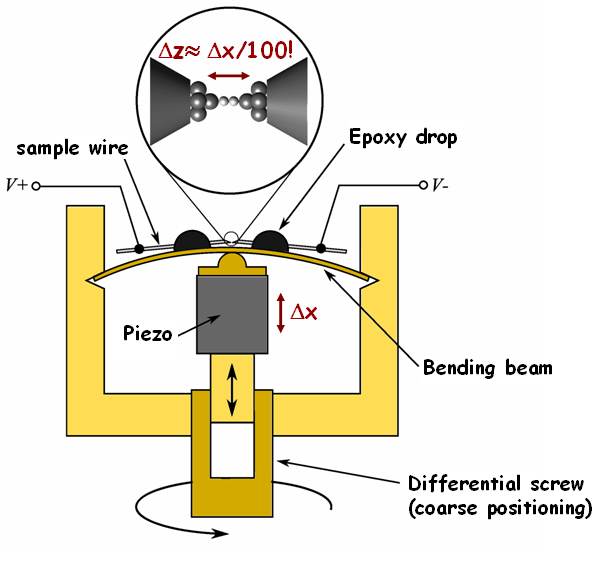
Schematics of a Mechanically controlable break junction
The basic principle consists in stretching the wire by bending the substrate with a mechanical actuator , until the junction breaks and gives two separate electrodes. Relaxing the force on the elastic substrate by back-bending allows the junction to be closed again. The mechanical actuator is composed of a stepping motor and a piezoelectric transducer (PZT) in series. The Au wire is glued onto a phosphorous bronze bending beam with two droplets of epoxy.
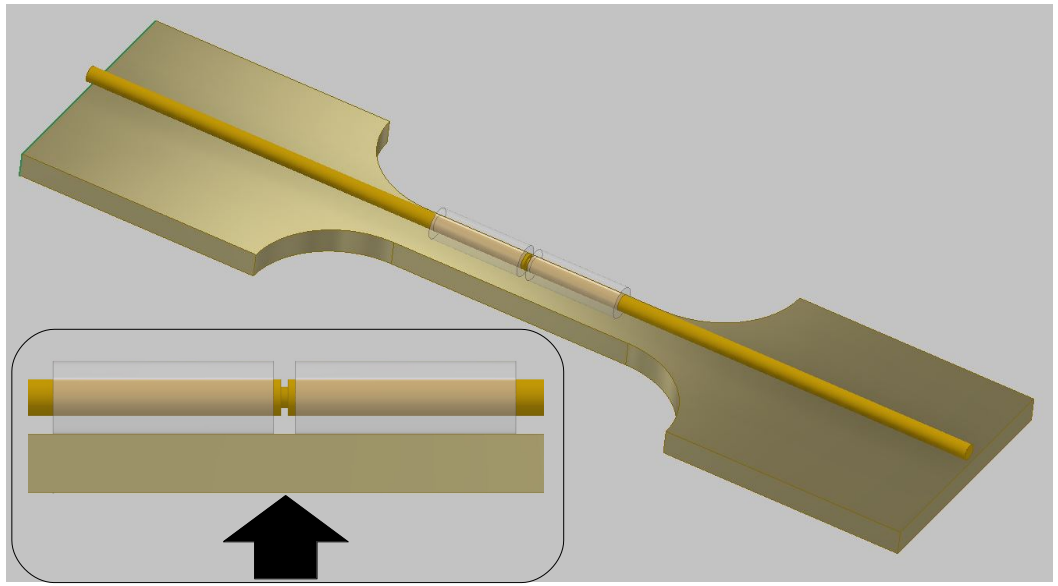
Schematic of aMCBJ sample
Schematic of the sample used for our MCBJ. The samples are made from Au wire glued into two quartz capillaries which are then glued onto a phosphorous bronze bending beam. As seen in the inset, the wire is notched in the empty space between the capillaries to initiate the breaking of the junction. These samples allow to work in liquid and in air
Properties of gold point contacts

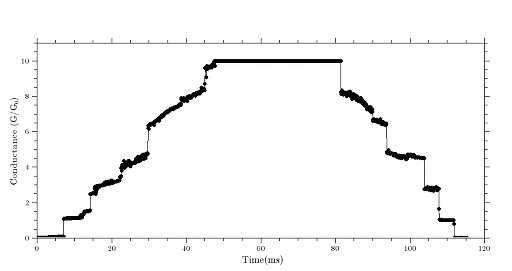
Conductance-elongation curves of gold atomic wire measured using a STM
Observation of Landauer conductance plateaus (prefered conductance values are integer multiple of G0)
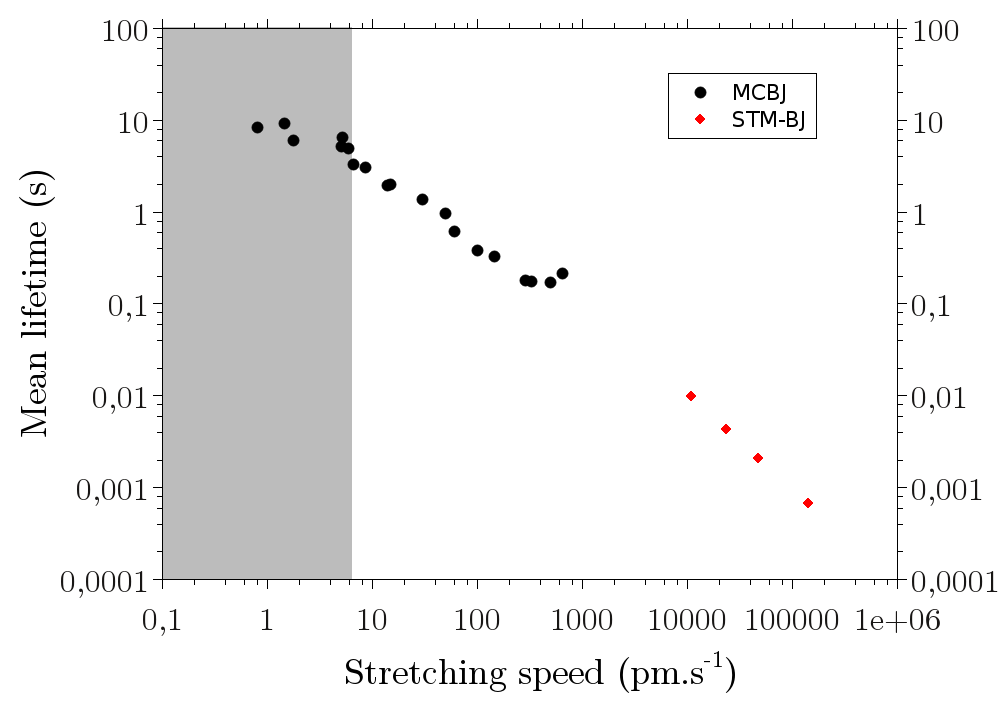
Lifetimes of monoatomivc gold contacts vs stretching speed of the electrodes
Lifetimes of ballistic plateaus at 1 G0
The dependence of the lifetime of ballistic plateaus at 1 G0 on the stretching speed shown in the figure,indicate that the breaking is due to the strain applied to the junction, for stretching speed higher than 10 pm/s. Indeed the strain increase with the stretching speed, and thus the lifetime decreases. For lower stretching speed, the contacts breaking is due to thermal motion.
Light emission from atomic point contacts
Gold atomic point contacts are prototype systems to evidence ballistic electron trans- port. The typical dimension of the nanojunction being smaller than the electron-phonon interac- tion length, even at room temperature, electrons transfer their excess energy to the lattice only far from the contact. At the contact however, favored by huge current densities, electron-electron interactions result in a nano hot electron gas acting as a source of photons.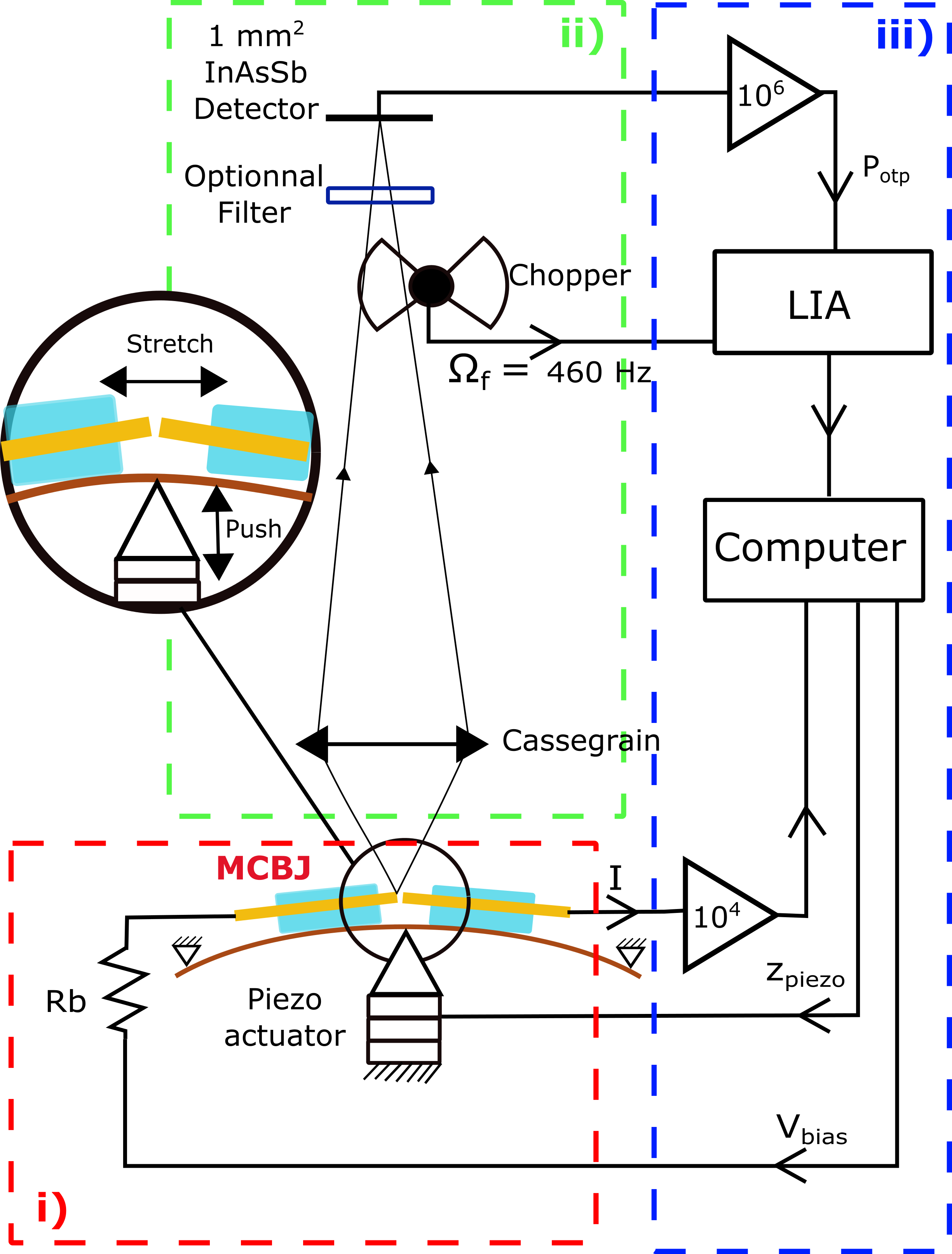
Experimental set-up i) MCBJ with a piezo actuator. Photons are collected using a reflective Cassegrain objective (15x, N.A.=0.5), optionnally filtered and chopped at 460 Hz and detected using a cooled InAsSb IR detector ii). The mag- nified view shows the MCBJ principle (push-to-stretch move- ment). The control and acquisition electronic consists of i) a current-voltage convertors,ii) a lock-in amplifier (LIA) and iii) a computer.
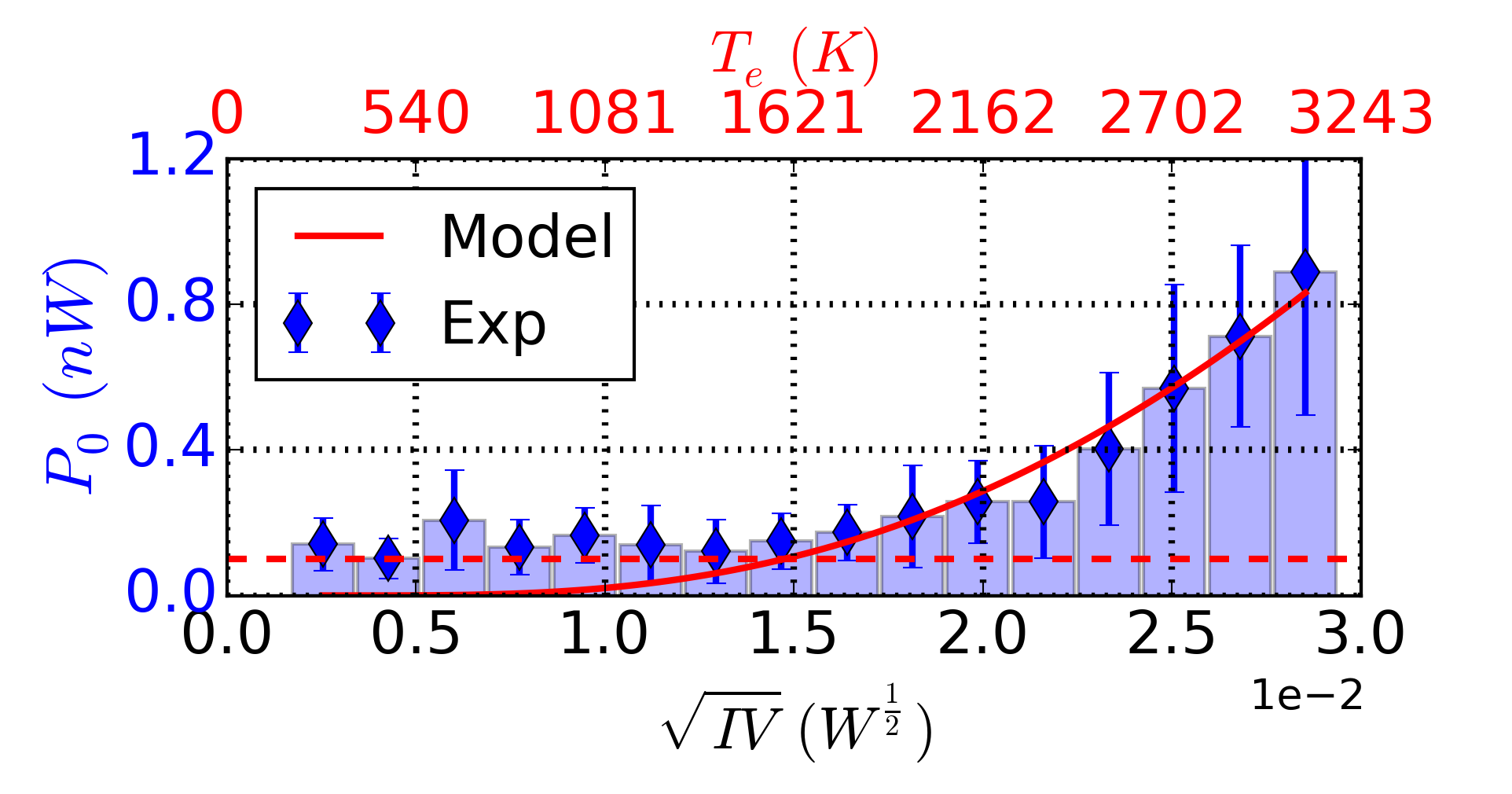
Determination of the equivalent hot electrons temperature
Experimental (blue columns) and calculated (red con- tinus line) dependences of the optical power P 0 with IV . Blue columns correspond to the mean value of the optical power over a binned x-axis. Error bars show the standard deviation cal- culated over the same binned x-axis. The calculated continous line allows the determination of the equivalent hot electrons temperature T_e shown on the top x-axis. The dashed horizontal red line represents the noise floor of the optical detector.
References
- Malinowski T.; Klein, H.R.; Iazykov M. and Dumas Ph., Infrared light emission from nano hot electron gaz created in atomic point contacts Eur. Phys. Lett., 2016, 114, 57002
- Alwan, M.; Candoni, N.; Dumas, P. & Klein, H. Statistical evidence of strain induced breaking of metallic point contacts Eur. Phys. J. B, 2013, 86, 243
- Klein, H.; Leoni, T.; Zoubkoff, R.; Dumas, P. & Saul, A. Conductance fluctuations in gold point contacts: an atomistic picture Nanotechnology, 2012, 23, 35707-35707
- Leoni, T.; Zoubkoff, R.; Homri, S.; Candoni, N.; Vidakovic, P.; Ranguis, A.; Klein, H.; Saul, A. & Dumas, P., Are conductance plateaus independent events in atomic point contact measurements? A statistical approach Nanotechnology, 2008, 19, 355401-
- Agrait N.: Quantum properties of atomic-sized conductors, Physics Reports, 2003, 377, 81-279
